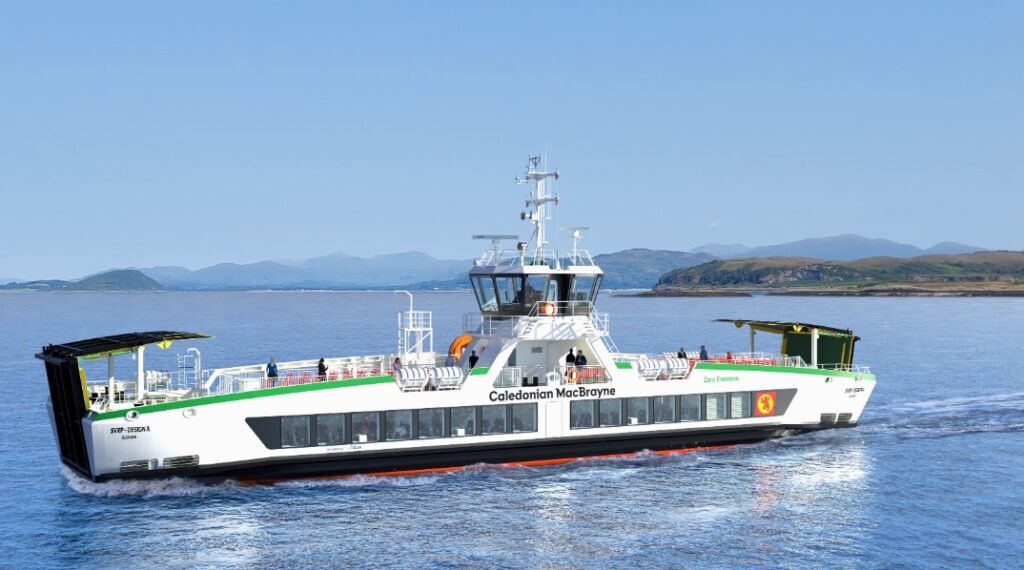Comparison between an electric ferry on a traditional 15.5-hour/day schedule and a permanent bridge open 24 hours for Strangford Lough, focusing on economy and connectivity between communities.

18th March 2025: Caledonian Maritime Assets Limited (CMAL) has awarded a £175 million contract for seven all-electric ferries to Polish shipbuilder Remontowa Shipbuilding, selecting them over Scotland’s nationalised Ferguson Marine shipyard. Remontowa received the highest score during the bidding process, with the first ferry expected to be operational by 2027. Ferguson Marine’s bid, though highly rated for quality, was more expensive than its competitors.
Electric Ferry on Traditional Schedule (15.5 Hours/Day)
WHO Regulations, Vehicle Idling, and Ramp Noise
- WHO Pollution Context: WHO air quality guidelines (PM2.5 at 5 µg/m³, NO₂ at 10 µg/m³) and IMO MARPOL Annex VI target emissions, including from docked ferries and queued vehicles. An electric ferry eliminates its own idling pollution, but cars queuing at slipways (especially peaks like summer weekends or commuter hours) emit PM2.5, NOₓ, and CO₂. Current Strangford ferry sees queues of 20–50 cars at peak, worse with 30-minute intervals and 30–50 car capacity. Assume 500,000 vehicles/year, ~1,370/day; peak hours (e.g., 8–10 a.m., 4–6 p.m.) could see 200–300 vehicles/day idling 10–20 minutes each. At 0.5g CO₂/minute/car (average petrol/diesel), ~6–12 tonnes CO₂/year from queuing, plus PM2.5/NOₓ spikes near homes (e.g., Portaferry’s slipway).
- Ramp Noise: Ferry ramps lowering/raising (metal-on-metal, hydraulic clanks) generate 70–90 dB at 10m, per maritime studies, audible 100–200m away. At 30-minute intervals, 20 hours/day, ~40 daily events per slip disrupt residents, especially near Portaferry’s tight-knit quay and Strangford’s quiet village. Electric ferries don’t reduce this—noise is mechanical, not engine-related.
Economy
- Capital Cost: £37M (£34M vessels, £3M charging).
- Operating Cost: £3.91M/year (electricity £2.91M, maintenance £0.5M, staff £0.5M). No direct WHO fines (ferry’s electric), but vehicle idling could prompt mitigation (e.g., £0.5M/year for signage, queue management).
- Revenue: £1M/year (500,000 passengers). Subsidy: £2.91M/year, potentially £3.41M with idling fixes.
- Total 25-Year Cost: £119.75M (£4.79M/year) base; £127.25M (£5.09M/year) with £7.5M idling mitigation.
- Economic Impact: Steady but stagnant. Queuing delays (10–20 minutes peak) deter tourists/businesses; ramp noise risks complaints or curfews, cutting revenue. No job growth beyond crew (10–15). Subsidy drain limits local investment. Cleaner air from electric ferry helps health/tourism marginally, but vehicle idling offsets gains.
Connectivity Between Communities
- Schedule: 15.5 hours/day, 8-hour gap. Queuing adds 10–20 minutes at peak, stretching trips to 25–40 minutes.
- Travel Time: 10-minute crossing, 25–40 minutes total peak (vs. 76 km detour’s 60–90). Non-peak: 15–20 minutes.
- Reliability: Weather, charging, and queue bottlenecks (e.g., 50-car cap exceeded) disrupt flow. Ramp noise doesn’t affect uptime but annoys residents.
- Access: Links Portaferry (2,500) and Strangford (500) decently, but peak queues and noise strain community tolerance. Growth capped; idling pollution hits slipway air quality.
Permanent Bridge (24 Hours, Modeled on Rose Kennedy Bridge) + £50M Approach Roads
WHO Regulations, Vehicle Idling, and Ramp Noise
- WHO Pollution: No ferry, no vehicle idling at slipways—traffic flows continuously, cutting queue emissions to near-zero locally. Construction emissions (~190,000 tonnes CO₂ for £190M, per industry norms) are one-off, not ongoing. WHO goals met long-term via cleaner transport.
- Ramp Noise: Eliminated—no ramps. Bridge traffic noise (50–60 dB at 50m, per Rose Kennedy data) is steady, less disruptive than intermittent 70–90 dB ramp clanks.
Economy
- Capital Cost: £190M (£125M bridge, £15M design, £50M roads). Roads upgrade A2 access, akin to Rose Kennedy’s £140M bypass-adjusted scale.
- Operating Cost: £0.4M/year (maintenance £0.3M, toll staff £0.1M).
- Revenue: £1.5M/year (500,000 vehicles × £3); growth to 885,900 vehicles/year = £2.66M/year. Profit: £1.1–2.26M/year.
- Total 50-Year Cost: £190M + £20M maintenance – £55M revenue = £155M (£3.1M/year); with growth, £77M (£1.54M/year).
- Economic Impact: High cost, high reward. Construction jobs (~700–1,200) and road upgrades boost short-term economy. 24/7 access, no queues, and silent operation drive tourism (e.g., Castle Ward), property values, and trade—Rose Kennedy’s New Ross saw retail/housing growth. Profits fund local projects vs. ferry’s subsidy sink. No idling/noise penalties enhance appeal.
Connectivity Between Communities
- Schedule: 24 hours/day. No queues, no downtime.
- Travel Time: 5–7 minutes total with upgraded roads. Saves 53–83 minutes vs. detour, consistently.
- Reliability: Weather-resistant; roads ensure smooth flow (Rose Kennedy handles storms). No idling/noise issues.
- Access: Fully merges Portaferry and Strangford—20,000 vehicles/day capacity supports growth (tourism, commuting). Roads tie into Belfast/Downpatrick, strengthening regional community bonds.
Comparison
Economy
- Ferry: £37M upfront, £119.75–127.25M over 25 years (£4.79–5.09M/year). WHO compliance for ferry is met, but vehicle idling adds £0–7.5M in costs (mitigation) and risks tourism loss from queues (10–20 minutes peak) and ramp noise (40 daily disruptions). Economic stagnation persists—£2.91–3.41M/year subsidy offers no growth.
- Bridge: £190M upfront, £77–155M over 50 years (£1.54–3.1M/year). No idling/noise costs; £50M roads amplify economic reach. Profits (£1.1–2.26M/year) and job creation (construction, tourism) echo Rose Kennedy’s uplift—Strangford Lough thrives long-term.
Connectivity Between Communities
- Ferry: 15.5-hour schedule, 25–40 minutes peak trips with queues, 15–20 non-peak. Idling pollution (6–12 tonnes CO₂/year) and ramp noise (70–90 dB, 40x/day) degrade dockside life, straining Portaferry-Strangford ties. Capacity limits integration.
- Bridge: 24/7, 5–7 minute trips, no queues/noise. Roads enhance access, uniting communities like Rose Kennedy did for New Ross. High capacity and silence foster shared growth—healthier, tighter links.
Conclusion
- Economy Favor: Bridge. Ferry’s £37M start is cheap, but £4.79–5.09M/year, idling costs, and noise complaints lock it as a drain. Bridge’s £190M (with roads) yields £1.54–3.1M/year and profits, driving Strangford Lough’s economy like Rose Kennedy’s success—noise/idling elimination is a bonus.
- Connectivity Favor: Bridge. Ferry’s 15.5-hour service falters with peak queues and disruptive ramps, weakening community bonds. Bridge’s 24/7 access, silent operation, and road upgrades fully connect Portaferry-Strangford, mirroring Rose Kennedy’s seamless integration.
The bridge’s £190M cost is steep, but it trumps the ferry’s escalating downsides—vehicle idling pollution and ramp noise tip the scales, making the ferry less viable under WHO pressure and community needs. Bridge wins for economy and connectivity. DfI decision time !
